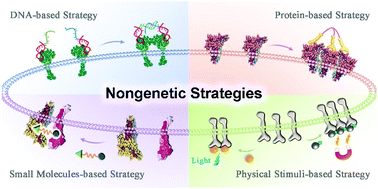当前位置:
X-MOL 学术
›
Chem. Soc. Rev.
›
论文详情
Our official English website, www.x-mol.net, welcomes your
feedback! (Note: you will need to create a separate account there.)
Nongenetic engineering strategies for regulating receptor oligomerization in living cells.
Chemical Society Reviews ( IF 40.4 ) Pub Date : 2020-02-10 , DOI: 10.1039/c9cs00473d Jingying Li 1 , Liping Wang 2 , Jinmiao Tian 3 , Zhilan Zhou 3 , Juan Li 4 , Huanghao Yang 2
Chemical Society Reviews ( IF 40.4 ) Pub Date : 2020-02-10 , DOI: 10.1039/c9cs00473d Jingying Li 1 , Liping Wang 2 , Jinmiao Tian 3 , Zhilan Zhou 3 , Juan Li 4 , Huanghao Yang 2
Affiliation

|
Cell surface receptors are important proteins that mediate communication between the cells and their outside environment, and also play essential roles in the control of a wide variety of biological processes, such as cell cycle, proliferation, communication, migration and apoptosis. Receptor oligomerization is an essential signal transduction mechanism that cell surface receptors use to transmit extracellular signals into the internal cytosol cellular machinery. Therefore, regulating receptor oligomerization provides an opportunity to customize cellular signaling and to direct cellular behavior in a user-defined manner. Some techniques have been developed for receptor oligomerization regulation, such as chemically induced dimerization (CID) and optogenetics, which involve traditional genetic engineering. However, the process of genetic manipulation is time-consuming, unpredictable and inefficient. Thus, development of nongenetic strategies for precisely regulating receptor oligomerization remains a desirable goal. Recently, along with the utilization of DNA, protein, small molecules and stimuli-responsive materials-based nongenetic engineering strategies, various receptor oligomerization and multiple cellular behaviors could be regulated, including migration, proliferation, apoptosis, differentiation and immune responses, etc. In this review, we aim to systematically introduce advances in the development of nongenetic engineering strategies for regulating receptor oligomerization, and provide insights into the existing challenges and future perspectives of this field.
中文翻译:

调节活细胞中受体寡聚的非基因工程策略。
细胞表面受体是重要的蛋白质,介导细胞与其外部环境之间的通讯,并且在控制多种生物学过程(例如细胞周期,增殖,通讯,迁移和凋亡)中也起着至关重要的作用。受体低聚是一种重要的信号转导机制,细胞表面受体可利用该信号转导机制将细胞外信号传递到内部细胞质细胞机器中。因此,调节受体低聚提供了以用户定义的方式定制细胞信号传导和指导细胞行为的机会。已经开发了一些用于受体低聚调节的技术,例如化学诱导的二聚化(CID)和光遗传学,这些技术涉及传统的基因工程。然而,基因操作的过程耗时,无法预测且效率低下。因此,开发精确调节受体寡聚的非遗传策略仍然是理想的目标。最近,随着DNA,蛋白质,小分子和基于刺激响应材料的非基因工程策略的利用,各种受体的寡聚化和多种细胞行为都可以得到调节,包括迁移,增殖,凋亡,分化和免疫反应等。这篇综述,我们旨在系统地介绍调节受体寡聚化的非基因工程策略的进展,并提供对该领域现有挑战和未来前景的见识。精确调节受体寡聚化的非遗传策略的开发仍然是理想的目标。最近,随着DNA,蛋白质,小分子和基于刺激响应材料的非基因工程策略的利用,各种受体的寡聚化和多种细胞行为都可以得到调节,包括迁移,增殖,凋亡,分化和免疫反应等。这篇综述,我们旨在系统地介绍调节受体寡聚化的非基因工程策略的进展,并提供对该领域现有挑战和未来前景的见识。精确调节受体寡聚化的非遗传策略的开发仍然是理想的目标。最近,随着DNA,蛋白质,小分子和基于刺激响应材料的非基因工程策略的利用,各种受体的寡聚化和多种细胞行为都可以得到调节,包括迁移,增殖,凋亡,分化和免疫反应等。这篇综述,我们旨在系统地介绍用于调节受体寡聚化的非遗传工程策略的进展,并提供对该领域现有挑战和未来前景的见识。
更新日期:2020-03-09
中文翻译:

调节活细胞中受体寡聚的非基因工程策略。
细胞表面受体是重要的蛋白质,介导细胞与其外部环境之间的通讯,并且在控制多种生物学过程(例如细胞周期,增殖,通讯,迁移和凋亡)中也起着至关重要的作用。受体低聚是一种重要的信号转导机制,细胞表面受体可利用该信号转导机制将细胞外信号传递到内部细胞质细胞机器中。因此,调节受体低聚提供了以用户定义的方式定制细胞信号传导和指导细胞行为的机会。已经开发了一些用于受体低聚调节的技术,例如化学诱导的二聚化(CID)和光遗传学,这些技术涉及传统的基因工程。然而,基因操作的过程耗时,无法预测且效率低下。因此,开发精确调节受体寡聚的非遗传策略仍然是理想的目标。最近,随着DNA,蛋白质,小分子和基于刺激响应材料的非基因工程策略的利用,各种受体的寡聚化和多种细胞行为都可以得到调节,包括迁移,增殖,凋亡,分化和免疫反应等。这篇综述,我们旨在系统地介绍调节受体寡聚化的非基因工程策略的进展,并提供对该领域现有挑战和未来前景的见识。精确调节受体寡聚化的非遗传策略的开发仍然是理想的目标。最近,随着DNA,蛋白质,小分子和基于刺激响应材料的非基因工程策略的利用,各种受体的寡聚化和多种细胞行为都可以得到调节,包括迁移,增殖,凋亡,分化和免疫反应等。这篇综述,我们旨在系统地介绍调节受体寡聚化的非基因工程策略的进展,并提供对该领域现有挑战和未来前景的见识。精确调节受体寡聚化的非遗传策略的开发仍然是理想的目标。最近,随着DNA,蛋白质,小分子和基于刺激响应材料的非基因工程策略的利用,各种受体的寡聚化和多种细胞行为都可以得到调节,包括迁移,增殖,凋亡,分化和免疫反应等。这篇综述,我们旨在系统地介绍用于调节受体寡聚化的非遗传工程策略的进展,并提供对该领域现有挑战和未来前景的见识。











































 京公网安备 11010802027423号
京公网安备 11010802027423号